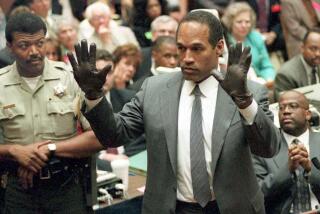Geppettos in the Corner Suite
- Share via
Hollywood nowadays films many of its yarns elsewhere, but that isn’t stopping plenty of industry insiders from bemoaning the fact that the courthouse drama featuring Michael Eisner and Michael Ovitz is being acted out across the country, in sleepy Delaware. But however inconvenient it is for those who’d love to watch firsthand the humbling of the two Michaels, the Delaware venue is appropriate.
Delaware, the state of incorporation for most major companies, plays a central role in setting the nation’s corporate law, and the Eisner-Ovitz trial, besides offering an enticing glimpse into the world of Hollywood moguldom, promises to be a landmark case that forces directors at all publicly traded companies to get serious about protecting shareholder interests.
The issue before the court is whether there is any reasonable explanation for Ovitz, once hailed as the most powerful man in show biz, to have been paid $109 million in severance in 1996 after serving for only a year as president of the Walt Disney Co. Shareholders allege that the outrageous payoff (amounting to the full value of Ovitz’s five-year contract) to the former buddy of Chief Executive Eisner shows the extent to which directors violated their fiduciary duties by allowing Eisner to treat the publicly traded company as his personal fiefdom.
This trial can’t be much fun for Eisner because it forces him to revisit the time when it all began to go so wrong. For some time now, Eisner has been a King Lear-like figure trying to cling to his throne at the Magic Kingdom. Earlier this year, amid a shareholder revolt, he was stripped of his chairman title and he announced he would step down as chief executive in 2006, but his detractors find it hard to wait that long.
It’s almost hard to recall that in the late 1980s and through much of the 1990s, Eisner was the golden boy who brought the Mouse roaring back to life. During the company’s stellar performance in Eisner’s early years, no one begrudged him his eye-popping pay -- more than $1 billion in his 20-year career at Disney (he made upward of $550 million in 1998 alone). Less noticed was the extent to which the cult of personality surrounding successful, charismatic chief executives like Eisner led to a relaxation of the checks and balances designed to keep the interests of a company’s management aligned with the interests of its shareholders.
At one point, Disney’s board included Eisner’s personal attorney, his architect and the principal of the elementary school his children had attended -- a handpicked bunch whose function seems to have been to rubber-stamp the chief’s every decision and sign off on his spectacularly lucrative compensation. That’s the same type of environment that at companies like Enron and WorldCom led to catastrophe.
Whatever happens in Delaware, investors in public companies across the country have already won. Boards of directors are learning that their actions will be reviewed and that directors will be held accountable. The Disney saga should also strengthen the Securities and Exchange Commission’s flagging resolve to pass reforms that would make it easier for shareholders to nominate independent directors. In the end, corporate Geppettos like Eisner may have a tougher time stacking their boards with Pinocchios, or may at least have to cut their strings.
More to Read
The biggest entertainment stories
Get our big stories about Hollywood, film, television, music, arts, culture and more right in your inbox as soon as they publish.
You may occasionally receive promotional content from the Los Angeles Times.










